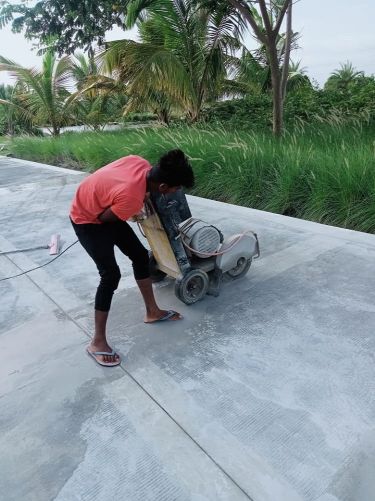- +91 89778 13526
- vdfconcepts609@gmail.com
GROOVE CUTTING
Groove cutting is a technique used in concrete flooring to create control joints that help to guide cracks along a predetermined line and to minimize the potential for long-term damage caused by concrete movement. The movement of concrete due to changes in temperature, moisture content, and drying of the cement can cause stress that can lead to cracks and instability. However, by cutting grooves into the concrete before it hardens, it becomes easier to control where the cracks will occur and to minimize their impact on the overall stability and appearance of the floor.
Groove cutting is typically performed using a circular concrete saw, which can be rented or purchased for use on the job site. It’s important to note that cutting hardened concrete requires specialized tools and expertise, and should only be performed by trained construction professionals, as it can be a dangerous task if not done properly. Nevertheless, groove cutting is an effective technique for controlling cracks and improving the overall durability and longevity of concrete flooring.

Procedure of Groove Cutting:
Groove cutting is a technique used in concrete flooring to create contraction joints, which are grooves cut into the concrete to help guide cracks along a predetermined line and minimize the potential for long-term damage caused by concrete movement. The process involves cutting grooves that are 5mm wide and one-third the thickness of the concrete, or as required at the job site, within 48 hours of laying the concrete. The grooves are filled with a suitable sealant to help prevent water and debris from entering the joints.
As you mentioned, concrete is constantly expanding and contracting due to changes in temperature, moisture content, and the drying of the cement, which can cause stress and result in cracks. By cutting grooves into the concrete before it hardens, the slab is weakened along a predetermined line and is more likely to crack in the grooves instead of somewhere else. This helps to control where the cracks will occur and to minimize their impact on the overall stability and appearance of the floor.
In heavy traffic areas, load transfer mechanisms may be used to prevent the concrete slabs from shifting and causing unevenness or damage to the joints. This can be done using dowels, load plates, or slots embedded into the concrete, which are laid perpendicular to the contraction joint and extend into both slabs across the joint. The purpose of these load transfer devices is to distribute the load evenly between slabs, thereby protecting the concrete along the joints and improving the overall durability and longevity of the floor.









